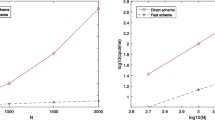Abstract
We propose and analyze a high order mixed finite element method for diffusion problems with Dirichlet boundary condition on a domain \(\Omega \) with curved boundary \(\Gamma \). The method is based on approximating \(\Omega \) by a polygonal subdomain \(\mathrm {D}_{h}\), with boundary \(\Gamma _h\), where a high order conforming Galerkin method is considered to compute the solution. To approximate the Dirichlet data on the computational boundary \(\Gamma _h\), we employ a transferring technique based on integrating the extrapolated discrete gradient along segments joining \(\Gamma _h\) and \(\Gamma \). Considering general finite dimensional subspaces we prove that the resulting Galerkin scheme, which is \({\mathbf {H}}(\mathrm {div}\,; \mathrm {D}_{h})\)-conforming, is well-posed provided suitable hypotheses on the aforementioned subspaces and integration segments. A feasible choice of discrete spaces is given by Raviart–Thomas elements of order \(k\ge 0\) for the vectorial variable and discontinuous polynomials of degree k for the scalar variable, yielding optimal convergence if the distance between \(\Gamma _h\) and \(\Gamma \) is at most of the order of the meshsize h. We also approximate the solution in \(\mathrm {D}_{h}^{c}\,{:}{=}\,\Omega \backslash \overline{\mathrm {D}_{h}}\) and derive the corresponding error estimates. Numerical experiments illustrate the performance of the scheme and validate the theory.








Similar content being viewed by others
References
Beuchler, S., Pillwein, V., Zaglmayr, S.: Sparsity optimized high order finite element functions for H(div) on simplices. Numer. Math. 122(2), 197–225 (2012)
Bramble, J.H., Dupont, T., Thomée, V.: Projection methods for Dirichlet’s problem in approximating polygonal domains with boundary-value corrections. Math. Comput. 26(120), 869–879 (1994)
Bramble, J.H., King, J.T.: A robust finite element method for nonhomogeneous Dirichlet problems in domains with curved boundaries. Math. Comput. 63, 1–17 (1994)
Bramble, J.H., King, J.T.: A finite element method for interface problems in domains with smooth boundaries and interfaces. Adv. Comput. Math. 6, 109–138 (1996)
Brenner, S.C., Scott, L.R.: The Mathematical Theory of Finite Element Methods. Texts in Applied Mathematics, vol. 15, 3rd edn. Springer, New York (2008)
Bertrand, F., Starke, G.: Parametric Raviart–Thomas elements for mixed methods on domains with curved surfaces. SIAM J. Numer. Anal. 54(6), 3648–3667 (2016)
Bertrand, F., Müzenmaier, S., Starke, G.: First-order system least squares on curved boundaries: higher-order Raviart–Thomas elements. SIAM J. Numer. Anal. 52, 3165–3180 (2014)
Brezzi, F., Fortin, M.: Mixed and Hybrid Finite Element Methods. Springer Series in Computational Mathematics, vol. 15. Springer, New York (1991)
Ciarlet, P.G.: The Finite Element Method for Elliptic Problems. Studies in Mathematics and its Applications, vol. 4. North-Holland Publishing Co., Amsterdam (1978)
Colmenares, E., Gatica, G.N., Oyarzua, R.: Analysis of an augmented mixed-primal formulation for the stationary Boussinesq problem. Numer. Methods Partial Differ. Equ. 32(2), 445–478 (2016)
Cockburn, B., Gupta, D., Reitich, F.: Boundary-conforming discontinuous Galerkin methods via extensions from subdomains. J. Sci. Comput. 42(1), 144–184 (2010)
Cockburn, B., Sayas, F.-J., Solano, M.: Coupling at a distance HDG and BEM. SIAM J. Sci. Comput. 34(1), A2–A47 (2012)
Cockburn, B., Solano, M.: Solving Dirichlet boundary-value problems on curved domains by extensions from subdomains. SIAM J. Sci. Comput. 34(1), A497–A519 (2012)
Cockburn, B., Solano, M.: Solving convection–diffusion problems on curved domains by extensions from subdomains. J. Sci. Comput. 59(2), 512–543 (2014)
Cockburn, B., Qiu, W., Solano, M.: A priori error analysis for HDG methods using extensions from subdomains to achieve boundary conformity. Math. Comput. 83(286), 665–699 (2014)
Cockburn, B., Zhang, W.: A posteriori error estimates for HDG methods. J. Sci. Comput. 51(3), 582–607 (2012)
Davis, T.A.: Algorithm 832: UMFPACK V4.3—an unsymmetric-pattern multifrontal method. ACM Trans. Math. Softw. 30, 196–199 (2004)
Deng, S., Cai, W.: Analysis and application of an orthogonal nodal basis on triangles for discontinuous spectral element methods. Appl. Numer. Anal. Comput. Math. 2(3), 326–345 (2005)
Di Pietro, D.A., Ern, A.: Mathematical Aspects of Discontinuous Galerkin Methods. Mathématiques & Applications (Berlin) [Mathematics & Applications], vol. 69. Springer, Heidelberg (2012)
Gatica, G.N.: A Simple Introduction to the Mixed Finite Element Method, Theory and Applications. Springer Briefs in Mathematics. Springer, Cham (2014)
Gatica, G.N., Ruiz-Baier, R., Tierra, G.: A mixed finite element method for Darcy s equations with pressure dependent porosity. Math. Comput. 85(297), 1–33 (2016)
Girault, V., Raviart, P.-A.: Finite Element Approximation of the Navier-Stokes Equations. Lecture Notes in Mathematics, vol. 749. Springer, Berlin (1979)
Hiptmair, R.: Finite elements in computational electromagnetism. Acta Numer. 11, 237–339 (2002)
Lenoir, M.: Optimal isoparametric finite elements and errors estimates for domains involving curved boundaries. SIAM J. Numer. Anal. 23, 562–580 (1986)
LeVeque, R.J., Li, Z.: Immersed interface methods for Stokes flow with elastic boundaries or surface tension. SIAM J. Sci. Comput. 18(3), 709–735 (1997)
Mori, Y.: Convergence proof of the velocity field for a Stokes flow immersed boundary method. Commun. Pure Appl. Math. 160, 1213–1263 (2008)
Peskin, C.S.: Flow patterns around heart valves: a numerical method. J. Comput. Phys. 10, 252–271 (1972)
Qiu, W., Solano, M., Vega, P.: A high order HDG method for curved-interface problems via approximations from straight triangulations. J. Sci. Comput. 69(3), 1384–1407 (2016)
Roberts, J.E., Thomas, J.-M.: Mixed and Hybrid Methods. Handbook of Numerical Analysis, vol. II, pp. 523–639. Elsevier, Amsterdam (1991)
Solano, M., Vargas, F.: A high order HDG method for Stokes flow in curved domains. https://ci2ma.udec.cl/publicaciones/prepublicaciones/prepublicacion.php?id=227
Stein, E.M.: Singular Integrals and Differentiability Properties of Functions. Princeton Mathematical Series, No. 30. Princeton University Press, Princeton, NJ (1970)
Author information
Authors and Affiliations
Corresponding author
Additional information
R. Oyarzúa acknowledges partial support from CONICYT-Chile through Project Fondecyt 1161325 and Project AFB170001 of the PIA Program: Concurso Apoyo a Centros Científicos y Tecnológicos de Excelencia con Financiamiento Basal and from Universidad del Bío-Bío through DIUBB Project GI 171508/VC. M. Solano acknowledges partial support from CONICYT-Chile through Project Fondecyt 1160320 and Project AFB170001 of the PIA Program: Concurso Apoyo a Centros Científicos y Tecnológicos de Excelencia con Financiamiento Basal. P. Zúñiga acknowledges Becas-Chile Program.
Appendices
Appendix
In this section we use the equivalence of the the norms \({\vert \vert \vert \cdot \vert \vert \vert }_e\) and \(\Vert \cdot \Vert _{0,{\widetilde{K}}_{ext}^{e}}\) (cf. Lemma 3.4) to provide an estimate of \({\widetilde{C}}_{ext}^{e}\) defined in (2.14).
Appendix A: Estimates of \({\widetilde{C}}_{ext}^{e}\)
The following result extends the estimation in [15, Lemma A.1] to the case when the norm \(\Vert \cdot \Vert _{0,{\widetilde{K}}_{ext}^{e}}\) is considered.
Lemma A.1
Let e be any edge in \({\mathcal {E}}_{h}^{\partial }\). Let \({\mathcal {L}}\) be the line segment with endpoints given by the center of the biggest ball contained in \(K^{e}\), and the point of the set \({\widetilde{K}}_{ext}\) where the polynomial p achieves its maximum. Suppose that assumption (A.1) holds. Assume further that \({\mathcal {L}}\) is contained in interior of the closure of the set \(K^{e}\cup {\widetilde{K}}_{ext}^{e}\), denoted by \(B^{e}\). Then, for any \(p\in \mathrm {P}_{l}(B^{e})\) we have
where \({\widetilde{r}}_{e}\,{:}{=}\,{\widetilde{H}}_{e}/h_{e}^{\perp }\) and \(\eta _{e}\,{:}{=}\,1+2\gamma _{K^e} {\widetilde{r}}_{e}+2\Big (\gamma _{K^e}{\widetilde{r}}_{e}(1+\gamma _{K^e} {\widetilde{r}}_{e})\Big )^{1/2}\). Here the constant C solely depends on the shape-regularity constant \(\gamma _{K^e}\).
Proof
We begin by noting that \({\mathcal {L}}\) can be subdivided as
from which
owing to the relation \(|{\widetilde{K}}_{ext}^{e}|\le C{h_{K^{e}}{\widetilde{H}}_{e}}\). Next, we proceed as in [15, Lemma A.1] and prove that \(\Vert p\Vert _{\mathrm {L}^{\infty }(I_{ext}^{e})}\le \eta _{e}^{l}\Vert p\Vert _{\mathrm {L}^{\infty }(I_{int}^{e})}\). In fact, in virtue of [11, Lemma 4.3], this is fulfilled by observing that
where \(\rho _{K^{e}}\) is the radius of the biggest ball contained in \(K^{e}\), since \(h_{e}^{\perp }\le h_{K^{e}}\) and \(h_{K^{e}}\le \gamma _{K^e} \rho _{K^{e}}\). In addition, by standard scaling arguments there holds
Finally, the proof is completed by noting that \(h_{K^{e}}^{-1}\le \left( h_{e}^{\perp }\right) ^{-1}\le {\widetilde{r}}_{e}/{\widetilde{H}}_{e}\). \(\square \)
The previous result, together with the estimates in Lemma 3.4, implies that
Rights and permissions
About this article
Cite this article
Oyarzúa, R., Solano, M. & Zúñiga, P. A High Order Mixed-FEM for Diffusion Problems on Curved Domains. J Sci Comput 79, 49–78 (2019). https://doi.org/10.1007/s10915-018-0840-5
Received:
Revised:
Accepted:
Published:
Issue Date:
DOI: https://doi.org/10.1007/s10915-018-0840-5




